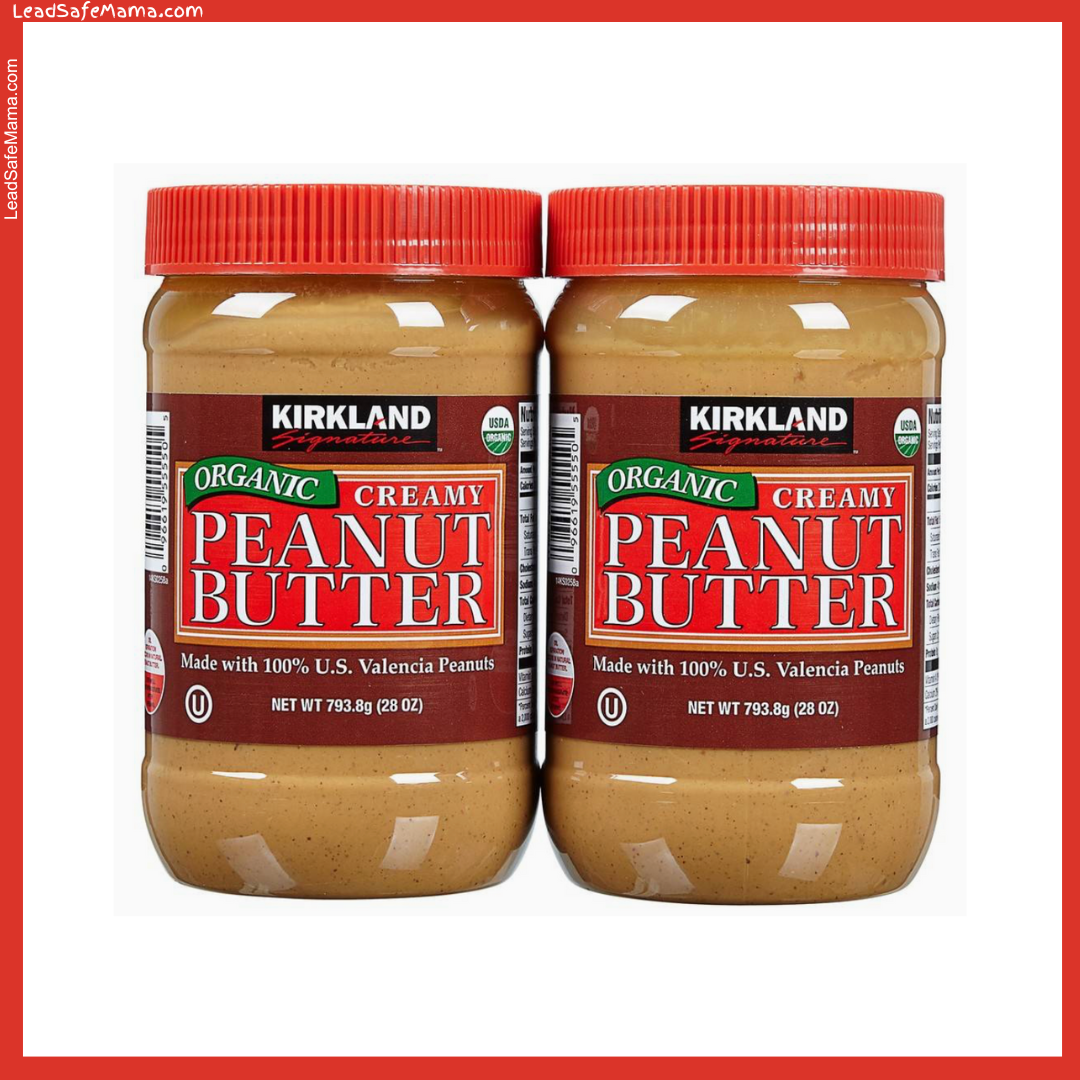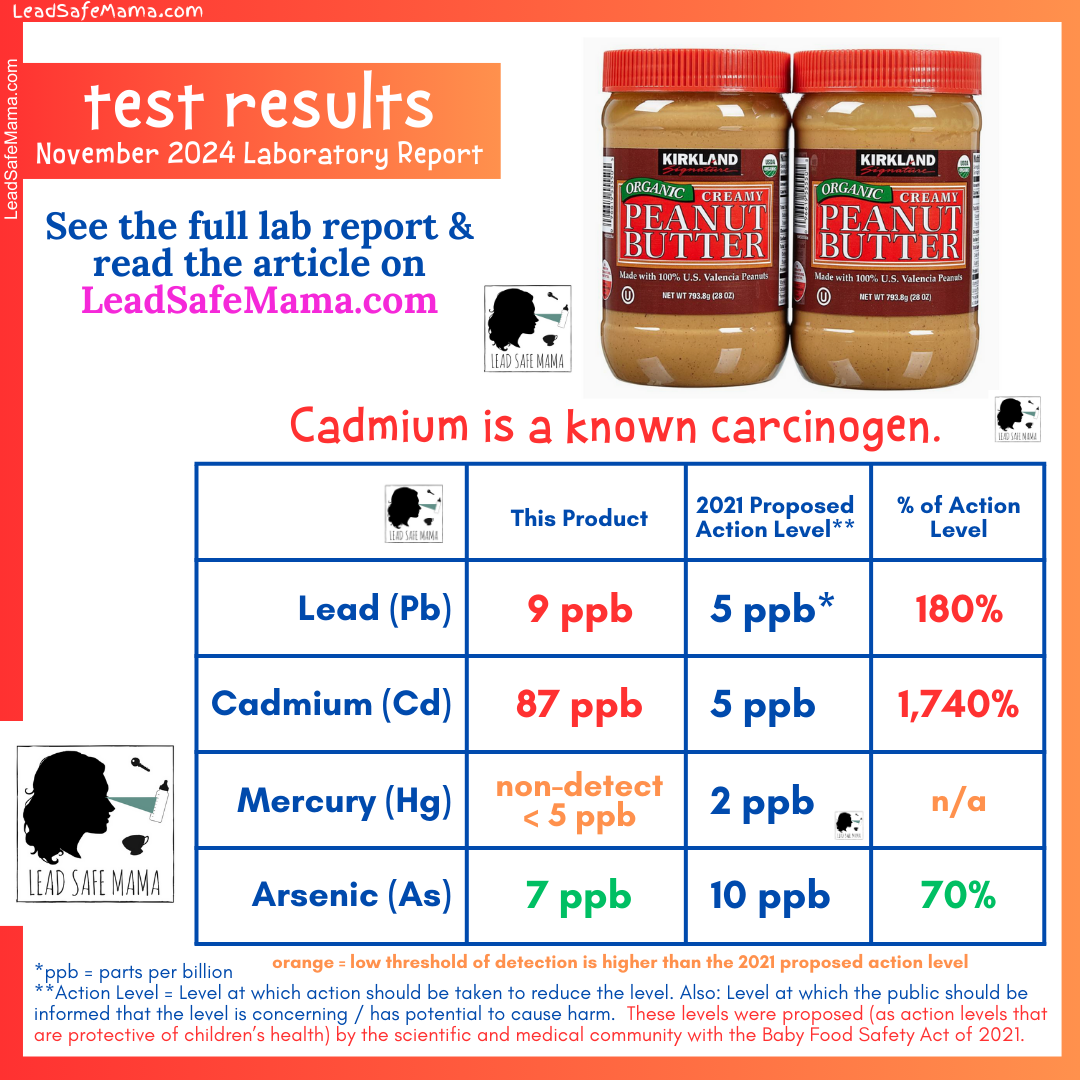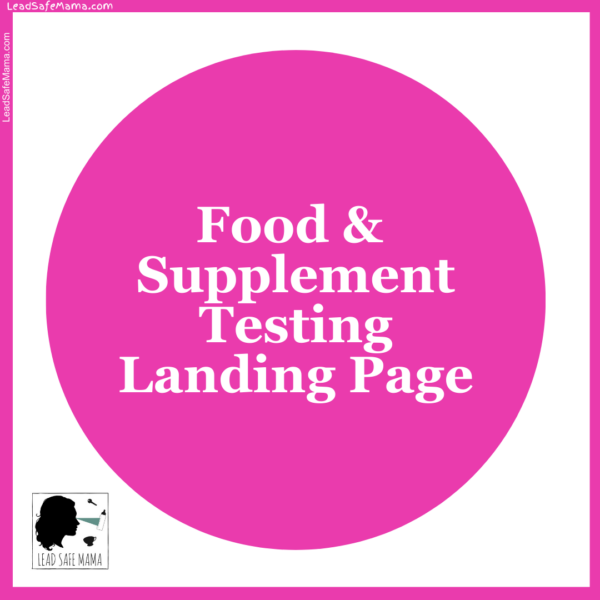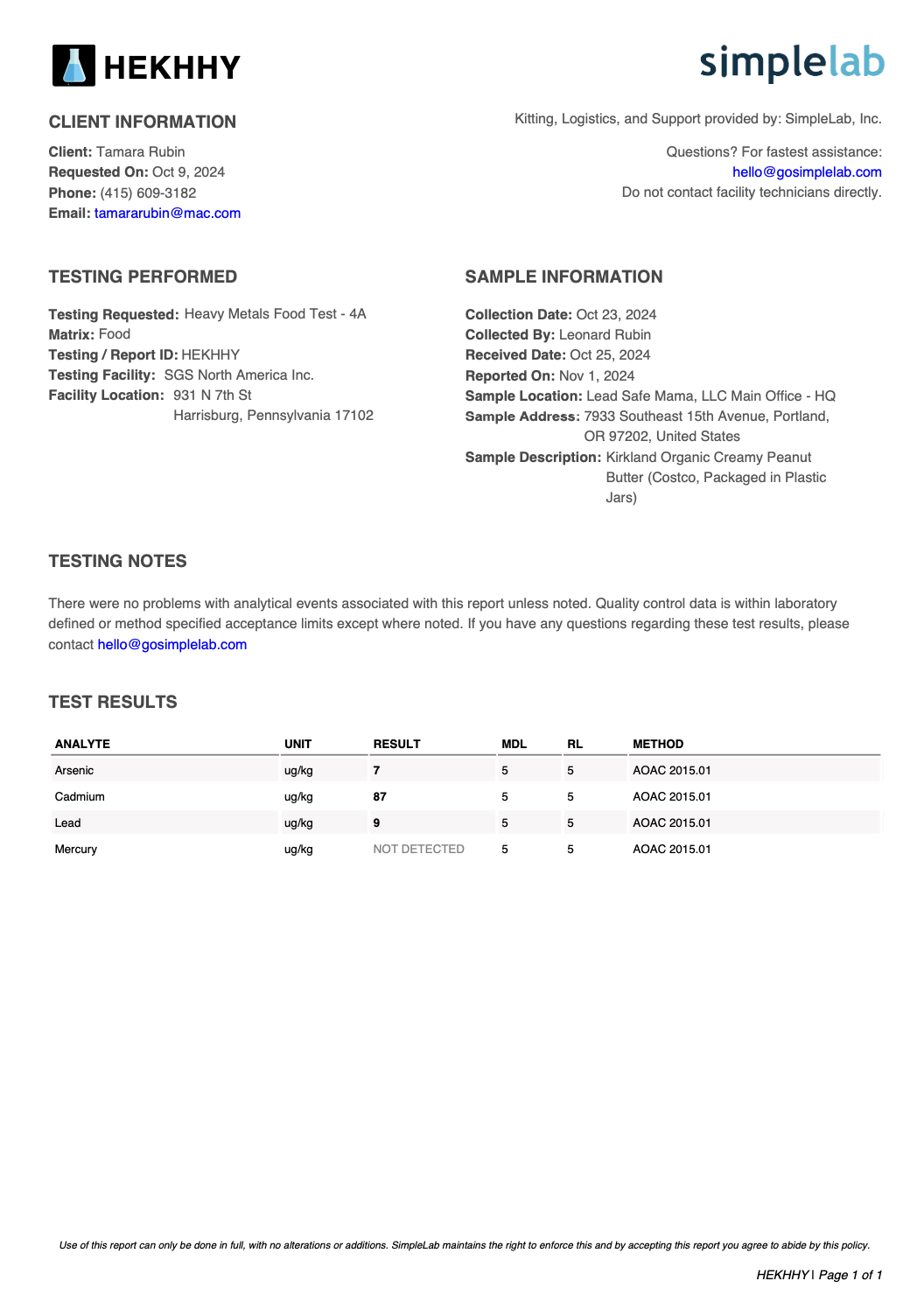Costco Kirkland Organic Creamy Peanut Butter (packaged in plastic jars) tests positive for Cadmium, Lead, & Arsenic: November 2024 Laboratory Report

Quick note from Tamara Rubin:
I have been informing readers about the concern for toxicants in this particular product for more than five years now, prompted initially when I was house-sitting for my friend Carissa and saw this product on the counter in her kitchen and decided to test the jar for toxicants using XRF testing. You can read my original article at this link — it provides important background regarding the source of potential toxicant contamination for this (and any other commercially-processed nut butters packaged in plastic jars).
The lab report we are sharing with this article (please scroll to the bottom for the full, original report) provides the results for Lead, Cadmium, Arsenic, and Mercury contamination of this product, which is the specific range of testing we have been conducting across the board when it comes to the food and supplement products we at Lead Safe Mama, LLC have been coordinating testing for since March 2024.
Antimony:
We will be publishing a “Part B” to this article in the coming week or two (as soon as we get the report back from the lab) with an additional laboratory test result for this product regarding the Antimony contamination. (Antimony is another known carcinogen in addition to the Cadmium found in these test results.) Specifically, this additional testing will answer the question of whether or not our theory (that this product may likely also have some level of Antimony contamination from the plastic container — the same common type that we have persistently found to test positive for Antimony in similar products) is true in this case.
I think it is also very important to take a moment here and re-share our recent lab report and article regarding SunButter Organic Sunflower Seed Butter (also packaged in plastic jars). Here’s the link to that article.
Here is a link to our original article (from several years ago) about the concern for toxicants in sunflower seed products in general.
Here’s a link to the language for the complaint we filed with the FDA about this product last month (October 2024).
To answer some questions we anticipate from those reading this article:
- This is the just first peanut butter product we have tested at this point, so we don’t yet know what to anticipate in terms of test results for any other peanut butter brands.
- We are surprised (to some degree) we have found such a high level of Cadmium in this product. We have been finding Cadmium in our food supply across the board, but had not previously had enough evidence to link it to peanut butter as another possible contributing source — specifically, although our test results for other peanut-flavored products could support a hypothesis of peanut butter being a contributing factor (in addition to chocolate) for Cadmium contamination in many popular food products. Here’s one such example of a Cadmium-contaminated peanut butter-flavored product: Justin’s Milk Chocolate Peanut Butter Cups. We assumed most of the Cadmium in this product was just attributable to the chocolate in this particular example (and similar examples), but we are now re-examining that assumption in light of the test results shared below!
- We do expect organic peanut butters packaged in glass to have a better toxicant profile (and, thus, that they would likely be a better choice) — but we do not yet have enough evidence to state this as more than an expectation since we do not yet have those test results back from the lab (though there is a sample from Santa Cruz Organic at the lab right now!).
- These processing and packaging concerns would be applicable to all types of commercially-produced nut butters, and we will continue to test packaged nut butters until we (hopefully) can identify one or more clean sources for families to use for sandwiches, baking, etc.
- In the meantime — other than recommending sticking with organic nut butters in glass jars (which should theoretically test better) — we do not currently have a recommendation for a known, lab-tested safer product or brand.
- Here’s a link to our overview article about all the safer products we have found through Lead Safe Mama, LLC’s community collaborative laboratory testing to date (specifically, products that tested “non-detect” for all four of the most common metallic toxicants). These products are linked below, but this article has more context for these non-detect findings and what they mean.
- We are not sharing this information with you to frighten, nor to “influence” you.
- We are sharing this information with you to help provide factual data, to empower you to make (your own) science-backed, informed decisions and choices for your own family.
- Now that you have this information you can make a choice as to whether or not you will use this product for your children. FYI, this product was already on my personal “no fly” list, as the Cadmium levels found are an indicator (again, for me personally) my family needs to put the brakes on eating peanut butter until we have more science, which hopefully uncovers the specific brand(s) that would be safest.
For those new to the Lead Safe Mama website:
Tamara Rubin is a multiple-federal-award-winning independent advocate for childhood Lead poisoning prevention and consumer goods safety, and a documentary filmmaker. She is also a mother of Lead-poisoned children (two of her four sons were acutely Lead-poisoned in 2005).
- Tamara owns and runs Lead Safe Mama, LLC — a unique community collaborative woman-owned small business for childhood Lead poisoning prevention and consumer goods safety.
- Since July 2022, the work of Lead Safe Mama, LLC has been responsible for six product recalls (FDA and CPSC).
- All test results reported on this website are science-based, accurate, and replicable.
- Please check out our press page to see some of the news coverage of our work — linked here.
This is an ad-free article.
Advertising and affiliate income help Lead Safe Mama, LLC cover the costs of the work we do here (independent consumer goods testing and childhood Lead poisoning prevention advocacy). We have removed ads from most of our more widely-read articles (and newly published articles, too — like this one!) to make them easier for you to read. In addition to supporting this work by starting any shopping you might be doing with a click on our affiliate links, if you would like to support the independent consumer goods testing and childhood Lead poisoning prevention advocacy work of Lead Safe Mama, LLC by making a contribution (which will also help us keep our more widely-read articles ad-free), click here. Thank you!
Important Background: What is an Action Level?
Please note the following key points:
The original lab report for this product is below (at the bottom of this page).
The graphic above shows the levels of metals detected in this product (in red) along with the low threshold of detection (in orange, above the action levels discussed/ or in green, below the action levels discussed) for each metal not detected with the laboratory testing Lead Safe Mama, LLC had completed for this product. The numbers are juxtaposed (in blue) to the “Action Level” proposed by the medical and scientific community in 2021 as part of the Baby Food Safety Act. For this round of testing, SimpleLab (our laboratory testing provider) had a change of labs and their low threshold of detection is slightly higher than in previous testing rounds.
- These 2021 levels were proposed as “Action Levels” because they are (in fact) protective of human health.
- An “Action Level” is NOT the same as a “Maximum Allowable Level.”
- Many food manufacturers misinterpret guidance on heavy metals to mean “allowable levels” and consider it reasonable for products to test positive below these levels.
- This is a (perhaps intentional?) misunderstanding/ misinterpretation the food industry makes — a misunderstanding that food manufacturers use to justify the presence of heavy metals in products.
- Heavy metals accumulate in the body.
- It is the cumulative/ aggregate impact of heavy metal exposure (over a lifetime) that makes even small/ incidental/ seemingly trivial exposures particularly damaging and dangerous. You can read more about that here.
- Once a food product has the amount of heavy metal (Lead, Cadmium, Mercury, or Arsenic) noted (above) as the “Action Level,” that product is officially considered (by the scientific and medical community) unsafe for consumption by children as toxicants (found at-or-above these levels) are in the range of heavy metal levels that have been demonstrated to cause lasting harm.
- Action Levels are unrelated to serving size.
- Action Levels are relevant for any amount of a food product that may be consumed (any quantity of the food in question).
- PPB (parts per billion/ ppb) measurements are a percentage (albeit a very small percentage) and apply to any quantity of the food product tested.
- For more discussion about serving size considerations (and why relying on “serving size” to limit toxicant exposure is not a relevant metric/ not a metric protective of human health), read this article.
- These “Action Levels” proposed in 2021 are the levels at which the scientific and medical community believe the manufacturer (or government) needs to take ACTION to fix the problem.
- One “Action” would be for the manufacturer to take steps to reduce the levels of toxicants in the food product.
- Another “Action” would be for the manufacturer to cease sales of the product until the product could be made safe.
- Another “Action” would be for the manufacturer to inform the public that a specific food product has an unsafe level of the metal detected at-or-above the “Action Level” — making a highly-visible public announcement regarding which relevant batches of the product should be recalled/ no longer consumed.
- The Action Levels proposed with the Baby Food Safety Act of 2021 were not arbitrary toxicant levels, but were proposed because they are the levels most protective of human health. However, the Baby Food Safety Act of 2021 was not passed into law.
- Regardless of the fact the Baby Food Safety Act of 2021 never passed into law — and it is therefore legal to have foods and supplements marketed for consumption by children test positive for Lead, Cadmium, Mercury, and Arsenic at-or-above these levels — these Action Levels still reflect the current (modern/ relevant) advice of the medical and scientific communities as levels both achievable by the industry and safeguards of infant and toddler health.
- Food and supplement industry lobbyists fought against formalizing these proposed “Action Levels” as a government standard, alleging the levels were unachievable.
- The list of safer choices (below) clearly demonstrate these Action Levels as achievable across a range of food types (salt, flour, coffee, oatmeal, chia seeds, hemp seeds, soy milk, packaged fruit-based snacks, beverages, and more).
- The legitimacy of these levels as “Action Levels”/ “Levels of Concern” (even though they were not adopted as law) is mirrored by the legitimacy of the American Academy of Pediatrics’ level of concern for Lead in water, which is 1 ppb despite the FDA’s official “level of concern” for Lead in water being 15 ppb (you can read more about that here).
“Simply Not Achievable”
To reiterate: While the packaged, processed food industry would have consumers (and the government) believe the standards proposed in 2021 are unachievable, this industry position (an oft-rearticulated response to nearly every set of laboratory test results for food and supplements that we have published to date) is simply not true.
It is possible to make safer processed, packaged food products and supplements that fall well below the safety limits for toxicants proposed within the Baby Food Safety Act of 2021. To wit, the products listed below (the first section of the list below) tested “non-detect” for Lead, Cadmium, Mercury, and Arsenic — several even tested non-detect for Lead with the low threshold of detection being “less than 1.5 ppb.”
Below is an EXPANDING list of products (foods and supplements) that have tested “non-detect” for Lead, Mercury, Cadmium, and Arsenic with independent, third-party, crowd-funded laboratory testing coordinated by Lead Safe Mama, LLC (an Oregon-based small business with a unique community-collaborative business model and a focus on consumer goods safety and childhood Lead poisoning prevention).
–
The limits of detection for each of the metals tested are noted in the lab report for the specific product listed. To see the full lab report for any of these products, type the brand name into the search bar at the top of any page on Lead Safe Mama dot com (and scroll down to the bottom of the related article).
–
Flavors tested are noted, and other flavors of the same product (or other products from the same brand) have either not been tested or have been tested but did not yield similar results. Test results only apply to the specific products linked below.
LIST UPDATED November 26, 2024:
- Beverage — Olipop Grape Tonic: https://amzn.to/4cjFYZu
- Breakfast Item — 1 — Nature’s Path Envirokidz Organic Panda Puffs: https://amzn.to/4fo1crf
- Breakfast Item — 2 — One Degree Organic, Gluten-Free, Sprouted Rolled Oats (Canada): https://amzn.to/3WIQ1BN
- Candy — Cavendish & Harvey Wild Berry Drops, not Organic (Germany): https://amzn.to/3Z1Jxjr
- Coffee — 1 — Chameleon Handcrafted Organic Cold Brew Concentrate: https://amzn.to/3OcrH77
- Coffee — 2 — Death Wish Organic Espresso Roast Ground Coffee (Multi-country Origin, non-USA): https://amzn.to/3yo1eiL
- Plant-Based Coffee Creamer — 1 — Laird Superfood Coconut Creamer: https://amzn.to/4fItA7A
- Dairy Coffee Creamer — 2 — Organic Valley Grassmilk Half and Half: https://amzn.to/4fHJIWT
- Fruit Snack — 1 — GoGo Squeez Organic Apple Sauce Pouch: https://amzn.to/3XhWYLe
- Fruit Snack — 2 — Pure Organic Layered Fruit Bars in Strawberry Banana Flavor: https://amzn.to/3WQEekA
- Fruit Snack — 3 — Once Upon A Farm Dairy Free Fruit Smoothie Pouch in Strawberry Banana Swirl Flavor: https://amzn.to/3CPMbAw
- Fruit Snack — 4 — Pure Organic Layered Fruit Bars in Raspberry Lemonade Flavor: https://amzn.to/3XcFsIp
- Infant Formula — 1 — Bobbie Organic Gentle Infant Formula Milk-Based Powder with Iron: https://amzn.to/3YYb849
- Infant Formula — 2 — Bobbie Grass-Fed Milk-Based Powder with Iron: https://amzn.to/3ZlAaeJ
- Infant Formula — 3 — ByHeart Infant Formula (USA-Made, not organic): https://amzn.to/48DJjTb
- Infant Formula — 4 — HiPP Bio Combiotik Infant Formula Powder – Stage 1 (imported)
- Infant Formula — 5 — Holle Bio Goat Stage 2 Infant Formula (for 6-10 months, organic, European — Swiss/ German/ Austrian) is not available on Amazon, but the Stage 3 version of this product is (not yet tested, but will likely test similarly): https://amzn.to/3BVU7zI
- Infant Formula — 6 — Kendamil Goat Infant Formula (not organic): This product may be available at Target (it is not available on Amazon)
- Infant Formula — 7 — Kendamil Organic Follow-On Milk (European/ British Toddler Formula, for 6-12 months, Cow Milk): Not available on Amazon (report link)
- Infant Formula — 8 — Kendamil Organic Infant Formula (Cow Milk): Not available on Amazon but may be available at Target
- Ingredient — 1 (salt) — Jacobsen’s Sea Salt (Oregon, USA): https://amzn.to/4dcbk5L
- Ingredient — 2 (baking flour) — Jovial Organic Einkorn Flour (Italy): https://amzn.to/3LIqxix
- Ingredient — 3 (seeds) — Costco Kirkland Organic Hemp Seeds: https://amzn.to/4e05RP9
- Ingredient — 4 (seeds) — Navitas Organic, Gluten-Free Chia Seeds (Mexico): https://amzn.to/3YvE7xC
- Oil — 1 — Chosen Foods 100% Avocado Oil (not organic): https://amzn.to/3YDZSuv
- Oil — 2 — Dr. Adorable’s Organic Perilla Seed Oil (Korea): https://amzn.to/3NDt7Yc
- Plant-Based Milk — 1 — Kiki Milk Organic Plant Based Milk (original flavor): https://amzn.to/3AA6Qrt
- Plant-Based Milk — 2 — West Soy Unflavored Unsweetened Organic Soy Milk: https://amzn.to/4dwev8l
- Supplement — 1 — Nordic Naturals Omega-3 Fish Oil: https://amzn.to/48q1j2V
- Supplement — 2 — Mary Ruth’s Organic Toddler Multivitamin Liquid Drops with Iron: https://amzn.to/3YPhcgx
Stand by for more!
–
BONUS FOUR: Below are FOUR additional products that each tested positive for trace (very low levels of) Arsenic — including the product featured above in this report — at levels considered safe by all standards (with the limits of detection noted in the lab report for the specific product listed):
- Infant Formula — Kendamil Goat Toddler Milk, not Organic (positive for traces of Arsenic): May be available at Target or through other online retailers of European infant formulas
- Fruit Snack — That’s It Apple Cherry Bars, not Organic (positive for traces of Arsenic): https://amzn.to/4fHkSWV
- Oil — Chosen Foods 100% Pure Avocado Oil — Organic (postive for traces of Arsenic): https://amzn.to/3BVQYQa
- Supplement — Now Sunflower Lecithin, not Organic (positive for traces of Arsenic): https://amzn.to/3AFdHzO
Amazon links are affiliate links.
Published: November 2, 2024
Saturday
Hello! We are working on publishing a LOT of test results very quickly this month.
We will be updating this section of each article (with more information about the specific product and other similar products for context) as time permits, but we wanted to make sure the greater Lead Safe Mama community (and the general public) had access to this scientific data (about foods and supplements in their home) as quickly as possible.
Please scroll down to see the full laboratory test report for the product pictured above. Thank you for your patience.
As there are almost no reasonable safety thresholds proposed for toxicants (heavy metals) consumed by adults (in foods and supplements), our focus is (as always) on the health of children. The available proposed safety thresholds (and guidance) for foods consumed by adults are not set at levels protective of human health and are therefore not relevant to the work we do here at Lead Safe Mama, LLC.
This is the Lead Safe Mama Amazon affiliate link to purchase a test kit similar to what we use for our laboratory testing.
To see more articles related to the laboratory testing for foods and supplements Lead Safe Mama, LLC is hosting (including background on this initiative and safer food choices and guidelines), click the pink square below. To see the full, independent, third-party laboratory report for the product pictured above, please scroll down to the bottom of this page.
Amazon links are affiliate links. If you purchase something after clicking on a Lead Safe Mama, LLC Amazon affiliate link, Lead Safe Mama, LLC may receive a percentage of what you spend — at no extra cost to you.
Lab report for the product pictured above:
Never Miss an Important Article Again!
Join our Email List










Interesting—Envirokids Panda cereal has peanut butter but came out clean across the board—this time at least. So some PB might be ok. One concern I have is that these test results are ‘snap shots’ of a product. If the producer decides to go with peanuts (or any other ingredient) from a different farm or area, I’m guessing the heavy metals could change (up or down)—unless they can control ALL of the heavy metal contamination during production. I suppose if at some point we are able to double-back and retest these same products, we will have a clearer picture.
After all this testing, I’m still concerned about lead, but I am far, far more concerned about cadmium as it seems to be present in most things, and in large amounts. We don’t eat much ‘processed food’ but single processed ingredients like this that test high are a worry. We eat a lot of nut and seed butters.
I seem to recall hearing that soil depletion and use of fertilizers can cause plants to take up more cadmium (instead of…?) but I need to go back and check if that’s really true and not just a theory.
We need to educate the food industry and the government of how to find the sources of contamination and eliminate them. And, we need to make the proposed action levels become the maximum allowable levels for foods eaten by humans of all ages. We need to do this in partnership. The food industry and the government should both hire you, Tamara Rubin, to help them achieve a safer food supply for us all.
Greetings,
I am a teenager fighting to get rid of lead from my parents household. My problem is that they have vintage bowls and plates, while I am eating with plain glass. Another problem is the amount of antiques. My father collects antiques, and me and my mother advise against it. Does he have to get rid of them?
I cannot find the Santa Cruz organic peanut butter test results? This has been the only peanut butter we buy, so eagerly awaiting this result. Have I just missed it? Still at the lab?
Thanks Tamara!
Jeanne
We don’t have that back from the lab yet. Please subscribe to the newsletter (subscribe portal is on every page of this website near the top) to get that (and other) test result as soon as it is published.
T
How about Nutzo brand- also sold in costco
Not familiar with that brand. You can nominate a food for testing by going to the food landing page and clicking the NOMINATE button. http://www.TamaraRubin.com/Food
When do you expect to get the Santa Cruz test results back?
They were published quite some time ago – just put “Santa Cruz” in the search bar.
T